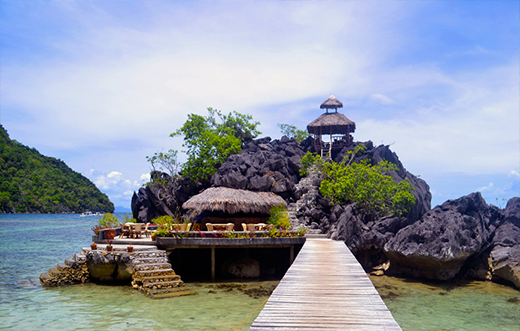
Located on the fringes of Asia’s main-stream tourist routes, the Republic of The Philippines – an archipelago nation consisting of more than 7,000 jewel-like, coral-fringed islands – remains one of the best-kept secrets of the Southeast Asian tourist trade and international scuba diving enthusiasts alike.
While recent census reports estimate the current population of the Philippines at 85-million inhabitants (concentrated within the three main geographical regions of Luzon, the Visayas, and Mindanao), many of this nation’s smaller outlying islands remain uninhabited and pristine ecological sanctuaries.
General Geography
The Philippine archipelago is divided into three major geographic regions: Luzon, the Visayas, and Mindanao. Within these regions, the nation is further divided into three distinct island groups.
The northern-most group includes the islands of Luzon, Mindoro, Marinduque, Masbate and Batanes. The central Visayan region includes Palawan, Panay, Negros, Cebu, Bohol, Leyte and Samar. The southern Mindanao region consists of Mindanao as well as all of the minor islands which make up the Sulu Archipelago.
Luzon – the largest contiguous land-mass in the country – is home to the nation’s political capitol of Manila. Comprising 105,000 square kilometers, Luzon is primarily recognized as the country’s seat of government and commerce.
The Visayas – comprising the nation’s middle-cluster of islands – is known for it’s dreamy little islands, white-sand beaches and crystal-clear shorelines filled with tropical marine life. Due to its idyllic scenery the Visayas has become a Mecca for tropical paradise seekers and scuba diving enthusiasts the world over.
Mindanao – the southern-most and second-largest island in the Philippines – offers the most distinct and varied topography in the country. A few miles offshore, in an area labeled “The Philippine Deep”, lies a 35,000 foot ocean trench which marks this area as the location of one of the greatest depths known on earth.
Natural Wonders
From north to south, the Philippine landscape provides a fascinating study in natural diversity. From region to region and island to island, emerald-colored rice terraces, active volcanoes, tropical rainforests, subterranean caves, underground rivers and tranquil islets greet the uninitiated visitor like some kind of lost Eden.
Edging the coastal landscape of nearly every major island are typically dozens – if not hundreds – of picturesque bays, lagoons and coves where water temperatures typically hover between the 25 to 30 degree range throughout the year.
In the Visayan region, and as already noted above, visitors will also find necklaces of incredible tropical islands ringed by coconut-studded white sand beaches and crystal clear waters filled with many varieties of rainbow-colored marine life.
Cultural Diversity
In the Philippines, East truly does meet West. The genetic background of the Philippine people, while dramatically eclectic, is primarily derived from Indonesian and Malay ancestry. Depending upon geographic location, visitors will also note a significant tint of Chinese and Spanish blood-lines.
The protracted influence of Spanish and American rule – as well as centuries of contact with various sea-going merchants and traders – has culminated in an uncommon blend of both physical appearance as well as cultural leanings and religious devotions and practices.
Manila – Colorful and Shrill
In stark contrast to the relative tranquility of outlying provincial areas, the Philippine capitol of Manila (currently estimated at around 19-million inhabitants) is a seething hot-bed of activity day and night.
For serious shoppers and casual browsers alike, Manila’s crazy-quilt of modern, western-styled shopping malls, and indigenous craft bazaars are experiences – and potential bargains – not to be missed. “Manila-By-Night” is also an exciting and multi-faceted experience few other capitol cities can claim.
Getting Around
Finding transport from one destination to another throughout Manila, as well as most outlaying provincial locations, is generally painless. Within Manila, you have transport options including modern elevated railway system, taxi-cabs, or any of the literally thousands of colorfully adorned “Jeepneys” which have become an international iconic symbol of this unique island nation.
Jeepneys, the most common means of local “mass-transit” available throughout the Philippines since World War II, are typically hand-built from stainless steel bodies and surplus engines. Each Jeepney is then custom finished with numerous coats of brightly colored paint and an ample supply of hand-cut adhesive stickers.
For short-distance travel, you may also ride a motorized “tricycle” – essentially a low-power, side-car-equipped motorcycles – or a human-powered “Pedi-Cab”. Either option – generally more abundant in provincial areas than in metro Manila – affords a cost-effective and culturally quaint mode of transport.


















